Metroid Prime 3: Quarterly Diaries #5
October 8th, 2009

Areas Covered: Elysia (Main Docking Bay)
Discussion Points: Hyper ball, Skytown Central Hub (my personal amnesia), engineering and interaction, Defense Drone mini-boss, Boost ball, license to kill
Elysia (Main Docking Bay)
In my last article I forgot to talk about the hyper ball ability gained after defeating Mogenar. Hyper ball allows Samus to enter hyper mode while in morph ball mode. The significance being that she can now radiate phazon to destroy overgrowth and other such matter. Considering that the morph ball bombs already do this, it seems like a needless addition and a pitiful award for the end of a chapter.
Anyways, back to schedule. I want to remark on the hub areas of Sky Town, but I’m not sure if my criticisms will be preempt and therefore unjust. Well, here goes…this area, much like the landing zones on Bryyo, often left me in limbo on where to go next, resulting in plenty of aimless wandering. Sky Town is a complicated web of multi-storied islands, so I naturally relied on the map quite heavily for directions. Yet, it seems as though the map screen split the world in a way in which I still can’t quite wrap my head around. There are at least two stories filling the interiors of the Sky Town area, yet the map seems to display only one floor at a time (the one you’re occupying). What made it tricky are the outdoor conduits and hubs which are represented the same on either floor. Maybe they aren’t, I need to seriously go back and check my facts, but it’s a tangle all the same.
In typical, if not a little excessive, Metroid fashion, the Sky Town area is riddled with plenty of new devices which drop obvious clues for the next slew of weapon upgrade. More points of interest to mentally flag down. Check. If you’ve played previous games, the respective power ups are obvious. In fact, your initial walk-through of Sky Town is practically a runway of upgrades including the boost ball, seeker missiles, spider ball and plasma beam. It’s a nice way to entice returning players in this way, I think.
It was somewhere around this point too where I got awarded the 400 kills achievement (and a stylish kill achievement for fending off the Steamlord). I don’t really like Retro using the word “kill” in a Metroid game. It doesn’t fit with the Metroid legacy nor the first person adventure (rather than FPS) theme of the Metroid Prime sub-series.
http://www.youtube.com/watch?v=LIfz_VJ5e8s</a>
Fast forward to 7 minutes in to see the room I am refering to, mind the commentary too.
Just before the Defense Drone mini-boss is a room called “Construction Bay” which I find of particular interest. Metroid Prime 3, most obviously with the boss battles already discussed, tends to layer abilities on top of each other to create interesting logic puzzles. It’s no new trick, but it’s clear in Metroid Prime 3 that Retro have become seasoned experts at composing these scenarios, and it makes Metroid Prime 3 feel all the more enjoyable. I like this room because of the way they pull in multiple assets and abilities into a single structure. You have the gates, also used on the flying fox, reused here along with the charge shot, grip pads, morph ball and grapple beam abilities. You must use the grip pads to climb up to the upper level of this structure and then crawl through a tunnel in morph ball mode to disarm the under-hanging gates so that you can freely swing across to the other side with the grapple beam. Your actions around the supporting structure, make you feel like part of the engineering and it allows you to appreciate not only the design but what the design speaks of in terms of cultural lore. By disarming the security measures it creates something of a kinship with it in understanding how it operates.
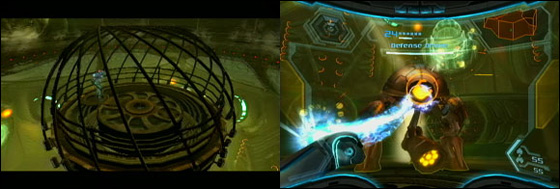
In the following room you’ll find an innocent looking upgrade. Walking towards it will prompt a cutscene with the power-up dropping beneath the floor. A barred, spherical cage then suddenly clamps around Samus, descending into an arena below. The cage retracts back into the floor and Samus is faced with the Defence Drone mini-boss. It’s a pretty spectacular opening. Not much needs to be said about the defence drone though, it’s another pasting of inner core, outer core et al design.
The boost ball ability left behind is much more interesting, or rather its application is. Previously in Metroid Prime 1 & 2 the boost ball was used to gain momentum along half-pipes and push against inclines. These applications still exist in Metroid Prime 3, but, at least for the time being, the boost is used to built up kinetic energy along circular tracks. The design suitably plugs back into the industrialised aspects of Sky Town’s aesthetic. Again, your participating in the engineering of the place.
With the boost ball you can now open the door blocking off the Aurora Unit. Yeah, I forgot to mention – your objective is to get the Aurora Unit back online to the main network. The Mother Brain-esque unit (just like the one on Olympus) is unhealthy, requiring you to enter an area underneath the main chamber and administer an antidote.

The Aurora Unit is a super interesting character due to it’s unmistakable similarities with Mother Brain. This is definitely no coincidence. Video from the Metroid channel Nintendo offered near release is also suggestive towards this assumption (see the end of the trailer, kinda suspicious, huh?). Colour me intrigued.
Once you’ve restored health to the unit, a corrupted Ghor reveals himself and uses his plasma beam to damage the mainframe and disconnect the unit from the main network. Ghor’s robotic nature makes him a suitable canidate for this area. I always liked Ghor because he’s just an asshole instead of a chest-beater like the other bounty hunters.
Shortly afterwards, the Aurora Unit asks you to obtain the plasma beam from Ghor, presenting an unusual dynamic which evoked a personal response. I’m not sure, something about this sequence felt out of place in a Metroid game, experimental yet at the same time within its means. There are two faces to this, let me cover them individually:
Bounty Hunter
Samus may be a bounty hunter, but she isn’t a gun for hire, she’s an investigator hired to check out conflict. The series has always made this distinction by presenting violence in a faceless manner, with Samus simply following through with her role as a law enforcer. Yet, in this off-beat moment you’re implicitly asked to kill with necessesary spoils granted for progress. Although the request isn’t overt about killing (acquire the plasma beam which is grafted onto Ghor who has gone rogue, hmm…I wonder what that involves), rarely has the series “discussed” your actions before with such loudness. Secondly, and maybe more importantly (I’m not too sure), you’re asked to attack a human-like creature rather than the local fauna/possessed version thereof. This is true of the other bounty hunters too though, but the games quite abruptly requested me to kill something non-plant-like, and that, to me, feels obtuse given the context. Maybe we’ll have to explore this one a little later.
The Ship
Upon leaving, transmissions chime in alerting you that your ship’s taking heavy damage. For some reason the destruction of my ship hastened my rush back to save the damned thing. It felt like a very urgent situation. The ship is practically the only other re-occuring “character” in the franchise, so you actually care about saving it from Ghor. I found that the transmission (two in total) legitimized my pursuit and eventual destruction of Ghor.’Ship as secondary character of Metroid series’, seems like another topic which warrants further investigation. Another time, another time.
Additional Readings
Commentaries and Examples of Work by Environment Artist
Metroid Prime 3: Quarterly Diaries #4
October 6th, 2009

This round we finally get off Bryyo and onto the next planet, Elysia. Having established a decent base of ideas so far, I probably won’t have as much to say about Elysia. On the other hand, I’ve been writing based on memory instead of writing while playing (which will change for the article after next), so it could go either way.
Areas Covered: Landing Site Delta, Elysia (Main Docking Bay)
Discussion Points: Dark World-esque visual design, Mogenar boss, Sky Town visual design, flying foxes
Landing Site Delta
Gnarly purples with a blue aura –welcome to Metroid Prime 2! The Dark World in MP2 was an intentionally ghastly place. The Dark World’s visual appearance was all the more frightening in its contrast against the charmingly rustic appeals of previous locales such as Agon Wastes, Temple Grounds and areas from the original Metroid Prime. Metroid Prime 2 took you out of the an archeologist’s environment and threw you into a subterranean abyss. This wild swing in visual design effectively pulled the rug out from under players and left them feeling in such a state.
The exact same dynamic works here too. This world is a repellent one and the eery setting prompts you along the linear corridors to Mogenar; the final boss of the Bryyo area.
Although the major boss battles in Metroid Prime 2 were set in the Dark World, the framework of these battles were so well made, so delectable for veteran players to grok, that it simply took the player away from the context and put them some place else. In saying that though, the visual bleakness only heightened the sense of drama and intensity which made the boss battles all the more exhilarating.
When the boss battle loses its edge though, the veneer falls apart and only worsens the situation, which pretty much sums up the confrontation with Mogenar.
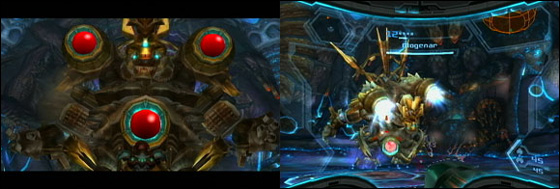
Clumsiness is again the order of the day, but I ought to first discuss the most glaringly obvious problem I have with Mogenar – those three red balls. ‘Form represents function’ is one of Nintendo’s core design principles. If an enemy has a certain weakness, such weakness should pertain the visual design. In this regard, the Mogenar creature is a little too ambitious. Hell, it doesn’t even attempt to disguise its weak points, and as a result looks unreservedly stupid.
To defeat Mogenar the player must first damage the four red balls (three on his front, one on his back) one at a time, repeat this step in hyper mode (to overload the energy of each one) and also attack his feet with morph ball bombs when necessary. This is the first time hyper mode has become a priority, almost to the point that it cripples the player in its over reliance.
After overloading one of the balls with phazon, Mogenar will launch into a dangerous offensive such as difficult to avoid electricity stomps or by rushing the player. In the latter case, the player must enter morph ball mode and then attack his crystallized feet to return him back to his normal state. For the player, it’s preferable that they overload more than one of the balls whilst in the one instance hyper mode, since entering the mode requires a submission of health tank (or half, I can’t remember!) and doing this four times over is suicide. Either of the two reactions by Mogenar severally obscures the player’s ability to attack another ball, and hence, with the time delay involved, Samus’ suit is more likely to overload with phazon, therefore requiring her to dispel it and forfeit her chance at attacking another ball. This scenario nudges the player into a difficult position and makes the confrontation a frustrating affair.
Elysia – Sky Town (Main Docking Bay)
Design-wise, it appears that each iteration in the Metroid Prime series seems to supercede the title before it by introducing a new and continually more breathtaking and iconic piece of landscape. Metroid Prime sported the peaceful ambiance of Phendrana Drifts. Metroid Prime 2 masterfully diverged from the traditional Metroid aesthetic with the technology driven Sanctuary Fortress. Metroid Prime 3 pushes the artistic beauty a further step forward with Sky Town.
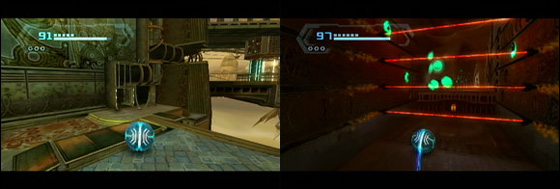
Consider Sky Town a steampunk-esque take on Sanctuary Fortress. Similarly, the two environments are a network of intricately detailed, multi-story islands connected in the sky. In contrast, Sky Town loses the cybernetic colour scheme, maintaining the rustic appeal of such areas as Chozo Ruins and Agon Wastes. It’s a design which embodies the series’ key visual strengths: the organic feel, rustic colours, minute detail and deft animation – it’s easy to feel sentimental.
Although Sky Town’s population are nothing but robot entities, the area still feels like a habitat. The worker drones are quietly working away, whilst the only enemies to interrupt your progress, the Wizard of Oz-inspired steambots, are sentries. The automation of any danger and innocuous worker drones create an environment that whilst populated is as quiet and sombre as some of the series’ best.
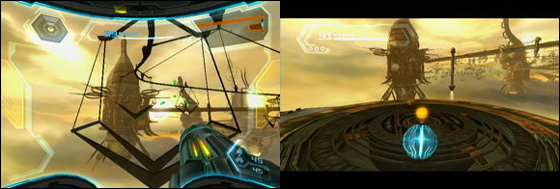
The floating islands constituting Sky Town are connected by an elaborate network of flying foxes. Samus uses the grapple beam to latch on to a fox and follows the windy trail to the other side. It’s a neat idea and is definitely enjoyable for the first few rounds but quickly becomes tiresome when you simply want to reach the other side without distraction.
Additional Readings
Metroid Prime Team Discusses Their Decade Of Samus, Ponders Series’ Future – Kotaku
Metroid Prime 3: Quarterly Diaries #3
October 4th, 2009

Areas Covered: Cliffside Airdock (Revisited), Firey Airdock (Revisited) Thorn Jungle Airdock
Discussion Points: Golumn subtext, backtracking, segregated area qualms, Korakk boss battle, Thorn Jungle, final two generators
Cliffside Airdock (Revisited)/Firey Airdock (Revisited)
After gaining the ice beam, the player must backtrack their way to the Cliffside Airdock area and mine a little deeper with the ice beam. This opens up a hidden sanctuary with the overbearing presence of a giant golem hooked up to tubes of that volatile yellow substance seen all throughout the Firey Airdock area. Another possible subtext. The lore scans throughout Bryyo tell the story of struggle between science and tradition within the culture of the extinct Primal race. The Chozo, who had first sparked the interest of science among the Primals, encouraged a balance between science and cultural tradition. Unfortunately the divisions of thought turned against each other and ultimately brought the demise of the civilisation. This story is best told through the scarring of the visual landscape. The war of ideologies has seen the falling of prominent structures in place of furnished technologies such as elevators, generators, transmission receivers and transport mechanisms. The golem is a highlight of this visual metaphor, an icon of the past bounded by the wrath of future industrialism and development.
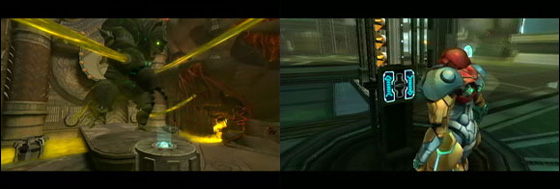
Free the golumn from his boundings and he opens an underground passage into a landing pad area for Samus’ ship. Here she can upgrade her ship to do something or other with the shields blocking access into the third area. I’m honestly not too sure. As mentioned, the objectives don’t sink well with me. Whatever happens you head back to the Firey Airdock and then eventually trek out to the Thorn Jungle area. So with all relevant upgrades finally gained, we can map the progressive structure so far like so;
Arrival at Cliffside Airdock -> Grapple Beam -> Arrival at Firey Airdock -> Ice Beam -> Return to Cliffside Airdock -> Ship upgrade -> Return to Firey Airdock -> Objective Complete
Hopefully this paints a clearer picture of the amount of required backtracking for this predominate section of the Bryyo area. Considering the next two parts on Bryyo are completely linear and (thankfully) require no planet-hopping it’s worth discussing my qualms with this dynamic now.
Maybe I’m blindingly stupid, but I frequently sent my ship to the wrong areas of the map*. You see, the planet-hopping dynamic tinkers with the play methodology in which the Metroid games have always comfortably facilitated. In prior Metroid titles, the entire world was overtly and in-overtly connected. Processing the entire world map mentally is therefore inherently challenging, hence when moving from one area to another my travel itinerary would be based on a linear path of recollected (often visual) set pieces within the environment chained together with a reliance on the room-by-room map system (ie.corridor, large room, corridor). My consciousness of the map is vague and reliant on “feeling out” the environment. Metroid Prime 3, in instances where the ship is used, forces me to assign these vague depictions to the fixed co-ordinate of a landing zone. I don’t get the opportunity to feel out the landscape and validate my hazy memory, rather I must make a preemptive decision based on invalidated recollections. I therefore feel that this system is counteracting with a piece of habitual comfort which the previous games formerly nurtured into growth.
Thorn Jungle Airdock
Shortly into the Throrn Jungle Samus duels with the Korakk Beast. So far, most of the boss battles have felt clumsy and the Korakk certainly conforms to this assumption. In fact, the process required to defeat Korakk is derivatively similar to the Rundas battle and the later battle with Ghor. You pinpoint a weakness, attack it (you need to enter morphball mode for this part), a “tug me” icon appears, you tug away with the grapple lasso, and then with weak spot revealed you whittle down the health. All of these bosses can be downed in the same formulaic fashion: weaken the outer layer, use the lasso to reveal the inner core and then attack that, with a few minor variances per battle.
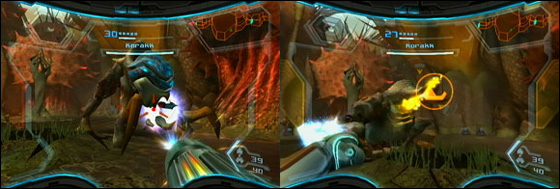
The battle itself is clumsy for three reasons: the weak spot around the mouth is tricky to judge and regularly flicks off when the Korakk prepares to tongue-grab you, the Korakk always attempts to lessen space between you and it which feels intrusive, and it’s awkward having to maneuver underneath him to bomb his under-belly region. The latter point is a result of too much overhang when the Korakk slouches in his weakened state, this knock backs the morphball and makes it awkward to slide under.
I probably should have mentioned the bizarrely amusing space pirate riding Korakk too. Very cute.
The following area of Thorn Jungle steps out of the jungle environment, and into a channel of confined areas wrought with dense technological and industrial impact. If prior areas were scarred by the mild influence of industrialisation, this part is the central core. We’ve seen this marked transition into the core; the Cliffside Airdock is the cultural hub of civilized life on Bryyo, the Firey Airdock is more industrious and features a couple of transmission centres. The Thorn Jungle is then the final visual chapter of the Primal’s story, a place where science rules. As you can see the story behind Bryyo is told on many levels: the visual story, the lore scans and the local flora and fauna. It’s the layering of each narrative piece (which to the player hardly comes across as narrative, and therefore feels very natural) that makes Retro’s artificial worlds so engrossing.
This area is headlined by a crossroads; a circular loop of connected corridors with the two remaining two generators on either side. Samus must destroy both generators, with the design allowing for a welcomed degree of non-linearity. Destroying each generator requires you to dismantle the power sources by flicking levers and attacking weak spots. You have to co-ordinate the event while fending off the defending space pirates. This scenario provides an open platform for players to flex their muscles; new players will dawdle and make mistakes, veteran players however can complete with relative ease and finesse. The pirates roll in thick and fast which makes hyper mode suddenly seem all the more useful.

This quality, fat free chunk of gameplay with a lack of backtracking and some neat diversity, feels like a reward for the somewhat arduous sections earlier on. I was in a different mood during these sequences, which accommodates the closing of this chapter nicely. Now, to Landing Site Delta for the final boss battle on Bryyo.
*On second thoughts, I am blindlingly stupid. There were only two options, I just couldn’t figure out which area I was already on. The point still stands and becomes more significant later in the game as you’ll see.
Additional Readings
Co-Op Metroid Prime Trilogy Ep



 Game Design Companion: A Critical Analysis of Wario Land 4 - $7.99
Game Design Companion: A Critical Analysis of Wario Land 4 - $7.99 Level Design: Processes and Experiences
Level Design: Processes and Experiences Speed Boost: The Hidden Secrets Behind Arcade Racing Design - $5.99
Speed Boost: The Hidden Secrets Behind Arcade Racing Design - $5.99 Adventures in Games Analysis: Volume I - $5.99
Adventures in Games Analysis: Volume I - $5.99







